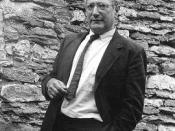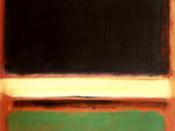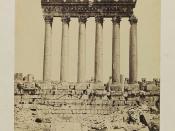Prior to 1940 Rothko often painted deserted city environments, adopting an expressionistic style. Subway Scene (1938) is one such painting. It is the depiction of a subway station and features: a policeman and another figure next to a figure in a ticket booth and some turnstiles; two figures passing each other on some stairs descending to a lower level; a figure just entering into view via steps to the back left. There are also four large pillars and a large set of railings.
There seems to be no shadowing and modelling is poor which makes it difficult to locate one individual light source. It also gives the figures a two dimensional appearance and makes them seem vacant and sombre. The tonal range is wide but the use of cool colours (in particular greys and blues) has the effect of distancing the spectator from the scene. Furthermore, emphasis is placed on colour rather than detail because the brushwork is crude.
These factors lend the scene a cold and somewhat eerie feeling.
Rothko's repeated use of vertical lines (specifically the railings and pillars) segregates the figures from one another and more significantly, from the spectator. The overlapping of these objects gives the scene perspective, but along with the idea of segregation and a high picture plane, this only serves to further distance the spectator.
The two left most pillars are arranged in such a way that they run parallel with the two right most pillars and with the wall at the back left of the scene. Furthermore the figures on the descending staircase and the figures around the ticket booth are along the same parallel plane,
and are framed within the pillars. The effect is that the eye is drawn towards the booth along this line. Perhaps then it is no...


